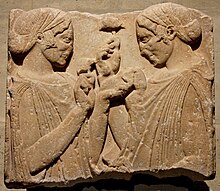Peplos
A peplos (Greek: ὁ πέπλος) is a body-length garment established as typical attire for women in ancient Greece by c. 500 BC, during the late Archaic and Classical period.
[3] It should not be confused with the Ionic chiton, which was a piece of fabric folded over and sewn together along the longer side to form a tube.
The Classical garment is represented in Greek vase painting from the 5th century BC and in the metopes of temples in the Doric order.
During the Panathenaea, the peplos was taken up to the Acropolis of Athens to be presented to the wooden statue of Athena Polias in the Erechtheion, opposite the Parthenon.
[4][5] The peplos had images of the mythic battle between gods and giants woven into its material and usually consisted of purple and saffron yellow cloth.

